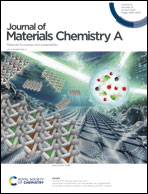Isolated cobalt–nitrogen sites on high-curvature carbon achieving industrial-level current density and pH-universal CO2 electroreduction†
Abstract
Achieving industrial-level current density and pH-universal CO2 reduction using single atom catalysts is a significant but challenging task. In this work, we demonstrate that isolated cobalt–nitrogen sites supported on high-curvature carbon could achieve industrial-level current density and pH-universal CO2 electroreduction to CO. In an H-type cell, the catalyst achieves a remarkable maximum CO faradaic efficiency of 98.2%, while maintaining CO faradaic efficiency above 90% over a wide potential window from −0.4 to −1.4 V vs. RHE. In a gas-diffusion flow cell, the CO faradaic efficiency could reach 98.9%, 96.5% and 98.6% in alkaline, acidic and neutral electrolytes, respectively. Impressively, the CO current density could reach 437, 337 and 367 mA cm−2, exceeding industrial-level current density requirements. In situ characterization studies coupled with theoretical calculations reveal that compared with the planar cobalt–nitrogen structure, the curved cobalt–nitrogen structure could effectively activate CO2, facilitate *COOH formation and inhibit the hydrogen evolution reaction, thus affording high activity, selectivity and pH-universal feasibility.



 Please wait while we load your content...
Please wait while we load your content...